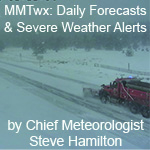- Posts: 28
- Thank you received: 7
RED CROSS-Driving in Winter Condition & If You get Stranded
- sweetiepie648
-
 Topic Author
Topic Author
- Leaf Peeper
-

Less
More
29 Apr 2017 09:21 #1
by sweetiepie648
Sharing American Red Cross
Driving in Winter Conditions & If You Get Stranded Guide Tips :cold: :cold: :cold:
Red Cross Volunteer Michelle Adams
DRIVING IN WINTER CONDITION
Check your vehicle emergency supplies kit and replenish it if necessary.
Bring enough of the following for each person:
- Blankets or sleeping bags
- Rain gear, extra sets of dry clothing, mittens, socks, and wool hats
- Newspapers for insulation
- Plastic bags for sanitation
- Canned fruit, nuts, and high energy snacks (Include a non-electric can opener if necessary)
- Warm broth in a thermos and several bottles of water
- Keep a cell phone or two-way radio with you. Make sure the battery is charged.
- Plan to travel during daylight and, if possible, take at least one other person with you.
Let someone know your destination, your route, and when you expect to arrive. If your vehicle gets stuck along the way, help can be sent along your predetermined route.
Before leaving, listen to weather reports for your area and the areas you will be passing through, or call the state highway patrol for the latest road conditions.
Be on the lookout for sleet, freezing rain, freezing drizzle, and dense fog, which can make driving very hazardous
IF YOU BECOME STRANDED
Stay in the vehicle and wait for help. Do not leave the vehicle to search for assistance unless help is visible within 100 yards (91 meters). You can quickly become disoriented and confused in blowing snow.
Display a trouble sign to indicate you need help. Hang a brightly colored cloth (preferably red) on the radio antenna and raise the hood after snow stops falling.
Run the engine occasionally to keep warm. Turn on the engine for about 10 minutes each hour (or five minutes every half hour). Running the engine for only short periods reduces the risk of carbon monoxide poisoning and conserves fuel. Use the heater while the engine is running. Keep the exhaust pipe clear of snow, and slightly open a downwind window for ventilation.
Leave the overhead light on when the engine is running so that you can be seen.
Do light exercises to keep up circulation. Clap your hands and move your arms and legs occasionally. Try not to stay in one position for too long.
If more than one person is in the vehicle, take turns sleeping. If you are not awakened periodically to increase body temperature and circulation, you can freeze to death.
Huddle together for warmth. Use newspapers, maps, and even the removable floor mats for added insulation. Layering items will help trap more body heat.
Watch for signs of frostbite and hypothermia. Severe cold can cause numbness, making you unaware of possible danger.
Drink fluids to avoid dehydration, which can make you more susceptible to the ill effects of cold and to heart attacks.
Avoid overexertion. Cold weather puts an added strain on the heart. Shoveling snow or pushing a vehicle can bring on a heart attack or make other medical conditions worse.
Driving in Winter Conditions & If You Get Stranded Guide Tips :cold: :cold: :cold:
Red Cross Volunteer Michelle Adams
DRIVING IN WINTER CONDITION
Check your vehicle emergency supplies kit and replenish it if necessary.
Bring enough of the following for each person:
- Blankets or sleeping bags
- Rain gear, extra sets of dry clothing, mittens, socks, and wool hats
- Newspapers for insulation
- Plastic bags for sanitation
- Canned fruit, nuts, and high energy snacks (Include a non-electric can opener if necessary)
- Warm broth in a thermos and several bottles of water
- Keep a cell phone or two-way radio with you. Make sure the battery is charged.
- Plan to travel during daylight and, if possible, take at least one other person with you.
Let someone know your destination, your route, and when you expect to arrive. If your vehicle gets stuck along the way, help can be sent along your predetermined route.
Before leaving, listen to weather reports for your area and the areas you will be passing through, or call the state highway patrol for the latest road conditions.
Be on the lookout for sleet, freezing rain, freezing drizzle, and dense fog, which can make driving very hazardous
IF YOU BECOME STRANDED
Stay in the vehicle and wait for help. Do not leave the vehicle to search for assistance unless help is visible within 100 yards (91 meters). You can quickly become disoriented and confused in blowing snow.
Display a trouble sign to indicate you need help. Hang a brightly colored cloth (preferably red) on the radio antenna and raise the hood after snow stops falling.
Run the engine occasionally to keep warm. Turn on the engine for about 10 minutes each hour (or five minutes every half hour). Running the engine for only short periods reduces the risk of carbon monoxide poisoning and conserves fuel. Use the heater while the engine is running. Keep the exhaust pipe clear of snow, and slightly open a downwind window for ventilation.
Leave the overhead light on when the engine is running so that you can be seen.
Do light exercises to keep up circulation. Clap your hands and move your arms and legs occasionally. Try not to stay in one position for too long.
If more than one person is in the vehicle, take turns sleeping. If you are not awakened periodically to increase body temperature and circulation, you can freeze to death.
Huddle together for warmth. Use newspapers, maps, and even the removable floor mats for added insulation. Layering items will help trap more body heat.
Watch for signs of frostbite and hypothermia. Severe cold can cause numbness, making you unaware of possible danger.
Drink fluids to avoid dehydration, which can make you more susceptible to the ill effects of cold and to heart attacks.
Avoid overexertion. Cold weather puts an added strain on the heart. Shoveling snow or pushing a vehicle can bring on a heart attack or make other medical conditions worse.
Please Log in or Create an account to join the conversation.
Time to create page: 0.113 seconds





